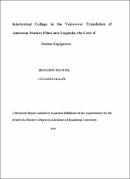| dc.contributor.author | Mugume, Benjamin | |
| dc.date.accessioned | 2022-03-18T08:44:18Z | |
| dc.date.available | 2022-03-18T08:44:18Z | |
| dc.date.issued | 2018 | |
| dc.identifier.citation | Mugume, Benjamin (2018). Intertextual college in the voice-over translation of American feature films into Luganda: the case of ''Firimu enjogerere''.Kyambogo University(Un published work) | en_US |
| dc.identifier.uri | Find full text in Barclays Library Rare section | |
| dc.identifier.uri | https://kyuspace.kyu.ac.ug/handle/20.500.12504/902 | |
| dc.description | xiv,273 p. | en_US |
| dc.description.abstract | This study examines voice-over translation of American feature films into Luganda as film
adaptation which involves the adaptation from film into an oral performance dubbed Firimu
Enjogerere. The study therefore runs along three strands namely translation, adaptation and
orature. First of all it is translation because the voice-over artiste known as the Video Jockey
(VJ) renders his own interpretation of the mise-en-scene, action, dialogue and the sounds of an
exotic film in Luganda a local language. Secondly, Firimu Enjogerere is adaptation because the
aptly named Video Jockey rides on the above mentioned elements of the original film to create
his/her own narrative in the new text which becomes a hybrid of Luganda orature and film
narrative.Thirdly Firimu Enjogerere is orature because the Video Jockey transcends the
traditional notion of Audio-Visual Translation (AVT) by performing orally before an audience
that is, to a great extent, more interested in the oral performance than the source film itself. The
study has adopted the term orature which was coined by Ugandan poet/playwright/author Pio
Zirimu in a ''rejection'' of the term oral literature( Ngugi:2007).
The study finds its rationale in two schools of thought namely; the reader response approach to
literary criticism whose guiding principle is that the reader/recipient of a literary text brings their
world view to its interpretation. Secondly, the view in narratology, advanced by scholar Gerard
Gennette, that a narrative is a composition of two distinct aspects; the story itself and the act of
telling it. In this study the source film is the story that is retold in an oral performance by the
Video Jockey. These theories account for the Video Jockey's act of interpretation/adaptation and
creation of a parallel or an alternative narrative to that of the ante-text. The study regards the
ante-text as the story whose telling has been supplanted by the Video Jockey's narration in what
becomes the adaptation. For analysis, the study uses two Firimu Enjogerere texts by Video
Jockey Kizito Tabula Ssalongo A.K.A. VJ Jingo namely: Baz Lurhmann's Romeo+Juliet (1996)
and Victor Salva's thriller Dark House (2014). The study relies on the work of African oral
literature scholar Ruth Finnegan to demonstrate that these two adaptations are indeed works of
orature. In the notion that orature is not confined to traditional forms alone the study finds
support in the view of scholars Russell Kaschula and Andre Mostert (2011) that orature has
merged or embraced modem technology in its nature and dissemination. (I) As regards
adaptation the dissertation deploys the theories of a number of film adaptation scholars. Kamilla
Elliot (2003) who believes that the content of a text can split from its form to emerge in another
form and suggests that images. like words. are translatable proposes six configurations in which
a source text can manifest in its adaptation. The study mainly utilizes two of these namely; the
trumping and ventriloquist modes of adaptation and bases on them to describe the way VJ Jingo
supplants and alters the elements in his adaptation of Baz Lurhmann's Romeo+Juliet (1996).
Additionally Kamilla Elliot's concept of a pychic mode of adaptation is used to describe the
way VJ Jingo captures what can be described as the spirit of Victor Salva' s Dark House (2014).
The study also appropriates Thomas Leitch's description of a curatorial adaptation in the
analysis of V 1 Jingo's rendering of Victor Salva's Dark House (2014 ). The study also
incorporates the typology and nomenclature of Gerard Gennette's trans textuality as well as
Robert Starn ·s (2000) view of adaptation as a conversation between two texts in his "Dialogies of
adaptation" (54 to 75). to describe the phenomenon of hybridity in Firimu Enjogerere. | en_US |
| dc.language.iso | en | en_US |
| dc.publisher | Kyambogo University(Un published work) | en_US |
| dc.subject | Firimu enjogerere | en_US |
| dc.subject | Transilation | en_US |
| dc.subject | English-Luganda | en_US |
| dc.title | Intertextual college in the voice-over translation of American feature films into Luganda: the case of ''Firimu enjogerere'' | en_US |
| dc.type | Thesis | en_US |

